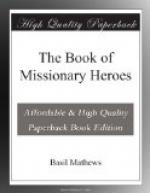Great was the joy of the rebels—their powerful enemy was in their hands! They bound him, threw him into a boat, hoisted him aboard a sailing ship and clapped him in the stifling darkness of the hold. As he lay there he pierced his arm to make it bleed, and, with the blood that came out, wrote on a piece of paper that was smuggled out and sent to Penang to Colonel MacInnes.
The agonies that Sabat suffered in the gloom and filth of that ship’s hold no one will ever know. We can learn from the words that he wrote in the blood from his own body that they loaded worse horrors upon him because he was a Christian. All the scene is black, but out of the darkness comes a voice that makes us feel that Sabat was faithful at the end. In his last letter to Colonel MacInnes he told how he was now ready (like his friend Abdallah) to die for the sake of that Master whom he had in his rage denied.
Then one day his cruel gaolers came to the hold where he lay, and, binding his limbs, thrust him into a sack, which they then closed. In the choking darkness of the sack he was carried on deck and dragged to the side of the ship. He heard the lapping of the waves. He felt himself lifted and then hurled out into the air, and down—down with a crash into the waters of the sea, which closed over him for ever.
FOOTNOTES:
[Footnote 58: The inn of the Near East—a square courtyard with all the doors and windows inside, with primitive stables and bunks for the camelmen, and sometimes rooms for the well-to-do travellers.]
[Footnote 59: Pronounce Vi-zah’-ga-pat-ahm.]
[Footnote 60: The Arabic New Testament revised by Solomon Negri and sent to India by the Society for the Promotion of Christian Knowledge in the middle of the eighteenth century.]
[Footnote 61: Baptized “Nathaniel” at Madras by the Rev. Dr Kerr.]
CHAPTER XXIV
A RACE AGAINST TIME
Henry Martyn
(Dates, b. 1781, d. 1812. Time of Incident 1810-12)
In the story of Sabat that was told in the previous chapter you will remember that, for a part of the time that he lived in India, he worked with an Englishman named Henry Martyn.
Sabat was almost a giant; Henry Martyn was slight and not very strong. Yet—as we shall see in the story that follows—Henry Martyn was braver and more constant than Sabat himself.
As a boy Henry, who was born and went to school in Truro, in Cornwall, in the West of England, was violently passionate, sensitive, and physically rather fragile, and at school was protected from bullies by a big boy, the son of Admiral Kempthorne.
He left school at the age of fifteen and shot and read till he was seventeen. In 1797 he became an undergraduate at St. John’s College, Cambridge. He was still very passionate.




